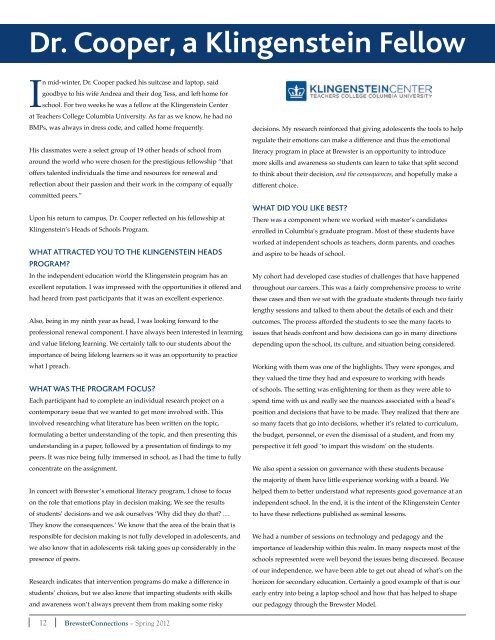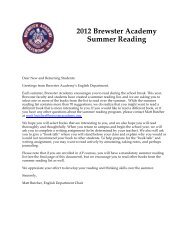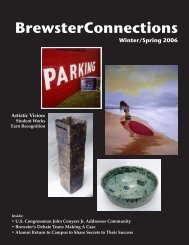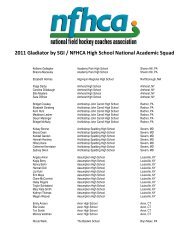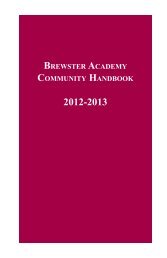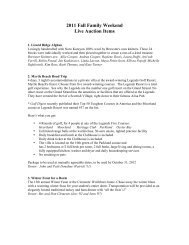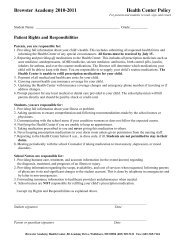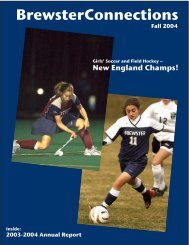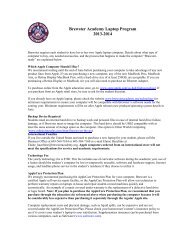BrewsterConnections(PDF) - Brewster Academy
BrewsterConnections(PDF) - Brewster Academy
BrewsterConnections(PDF) - Brewster Academy
You also want an ePaper? Increase the reach of your titles
YUMPU automatically turns print PDFs into web optimized ePapers that Google loves.
Dr. Cooper, a Klingenstein Fellow<br />
In mid-winter, Dr. Cooper packed his suitcase and laptop, said<br />
goodbye to his wife Andrea and their dog Tess, and left home for<br />
school. For two weeks he was a fellow at the Klingenstein Center<br />
at Teachers College Columbia University. As far as we know, he had no<br />
BMPs, was always in dress code, and called home frequently.<br />
His classmates were a select group of 19 other heads of school from<br />
around the world who were chosen for the prestigious fellowship “that<br />
offers talented individuals the time and resources for renewal and<br />
reflection about their passion and their work in the company of equally<br />
committed peers.”<br />
Upon his return to campus, Dr. Cooper reflected on his fellowship at<br />
Klingenstein’s Heads of Schools Program.<br />
What attracted you to the Klingenstein Heads<br />
program?<br />
In the independent education world the Klingenstein program has an<br />
excellent reputation. I was impressed with the opportunities it offered and<br />
had heard from past participants that it was an excellent experience.<br />
Also, being in my ninth year as head, I was looking forward to the<br />
professional renewal component. I have always been interested in learning<br />
and value lifelong learning. We certainly talk to our students about the<br />
importance of being lifelong learners so it was an opportunity to practice<br />
what I preach.<br />
What was the program focus?<br />
Each participant had to complete an individual research project on a<br />
contemporary issue that we wanted to get more involved with. This<br />
involved researching what literature has been written on the topic,<br />
formulating a better understanding of the topic, and then presenting this<br />
understanding in a paper, followed by a presentation of findings to my<br />
peers. It was nice being fully immersed in school, as I had the time to fully<br />
concentrate on the assignment.<br />
In concert with <strong>Brewster</strong>’s emotional literacy program, I chose to focus<br />
on the role that emotions play in decision making. We see the results<br />
of students’ decisions and we ask ourselves ‘Why did they do that? …<br />
They know the consequences.’ We know that the area of the brain that is<br />
responsible for decision making is not fully developed in adolescents, and<br />
we also know that in adolescents risk taking goes up considerably in the<br />
presence of peers.<br />
Research indicates that intervention programs do make a difference in<br />
students’ choices, but we also know that imparting students with skills<br />
and awareness won’t always prevent them from making some risky<br />
decisions. My research reinforced that giving adolescents the tools to help<br />
regulate their emotions can make a difference and thus the emotional<br />
literacy program in place at <strong>Brewster</strong> is an opportunity to introduce<br />
more skills and awareness so students can learn to take that split second<br />
to think about their decision, and the consequences, and hopefully make a<br />
different choice.<br />
What did you like best?<br />
There was a component where we worked with master’s candidates<br />
enrolled in Columbia’s graduate program. Most of these students have<br />
worked at independent schools as teachers, dorm parents, and coaches<br />
and aspire to be heads of school.<br />
My cohort had developed case studies of challenges that have happened<br />
throughout our careers. This was a fairly comprehensive process to write<br />
these cases and then we sat with the graduate students through two fairly<br />
lengthy sessions and talked to them about the details of each and their<br />
outcomes. The process afforded the students to see the many facets to<br />
issues that heads confront and how decisions can go in many directions<br />
depending upon the school, its culture, and situation being considered.<br />
Working with them was one of the highlights. They were sponges, and<br />
they valued the time they had and exposure to working with heads<br />
of schools. The setting was enlightening for them as they were able to<br />
spend time with us and really see the nuances associated with a head’s<br />
position and decisions that have to be made. They realized that there are<br />
so many facets that go into decisions, whether it’s related to curriculum,<br />
the budget, personnel, or even the dismissal of a student, and from my<br />
perspective it felt good ‘to impart this wisdom’ on the students.<br />
We also spent a session on governance with these students because<br />
the majority of them have little experience working with a board. We<br />
helped them to better understand what represents good governance at an<br />
independent school. In the end, it is the intent of the Klingenstein Center<br />
to have these reflections published as seminal lessons.<br />
We had a number of sessions on technology and pedagogy and the<br />
importance of leadership within this realm. In many respects most of the<br />
schools represented were well beyond the issues being discussed. Because<br />
of our independence, we have been able to get out ahead of what’s on the<br />
horizon for secondary education. Certainly a good example of that is our<br />
early entry into being a laptop school and how that has helped to shape<br />
our pedagogy through the <strong>Brewster</strong> Model.<br />
12 <strong><strong>Brewster</strong>Connections</strong> – Spring 2012


